Impressionism Woman Sitting Profile Outdoor White Dress Stream
A pioneer of Impressionism, Claude Monet painted some of the most beautiful and fleeting scenes of everyday life, but he was not only painting people and scenes for the sake of painting them – but he also painted his subject matter as conduits of color and light. This article will explore his Woman with a Parasol painting.
Table of Contents
- 1 Artist Abstract: Who Was Claude Monet?
- 2 Woman With a Parasol (1875) by Claude Monet in Context
- 2.1 Contextual Analysis: A Brief Socio-Historical Overview
- 3 Formal Analysis: A Brief Compositional Overview
- 3.1 Subject Matter
- 3.2 Color and Light
- 3.3 Perspective
- 4 Monet: Capturing the Moment
- 5 Frequently Asked Questions
- 5.1 Who Painted The Woman with a Parasol?
- 5.2 Who Are the Figures in Monet's The Woman with a Parasol Painting?
Artist Abstract: Who Was Claude Monet?
The Parisian, Oscar Claude Monet was born on November 14, 1840. He was artistic since he was a young boy and earned money by selling some of his art. He studied art at College du Havre during 1851 and then during 1858 he started studies at Académie Suisse. During 1861 and 1862 he was part of the Chasseurs d'Afrique military service. He also studied art at the Charles Gleyre studio.
Throughout Monet's artistic career he had numerous notable acquaintances and mentors who helped him home in on his skills.
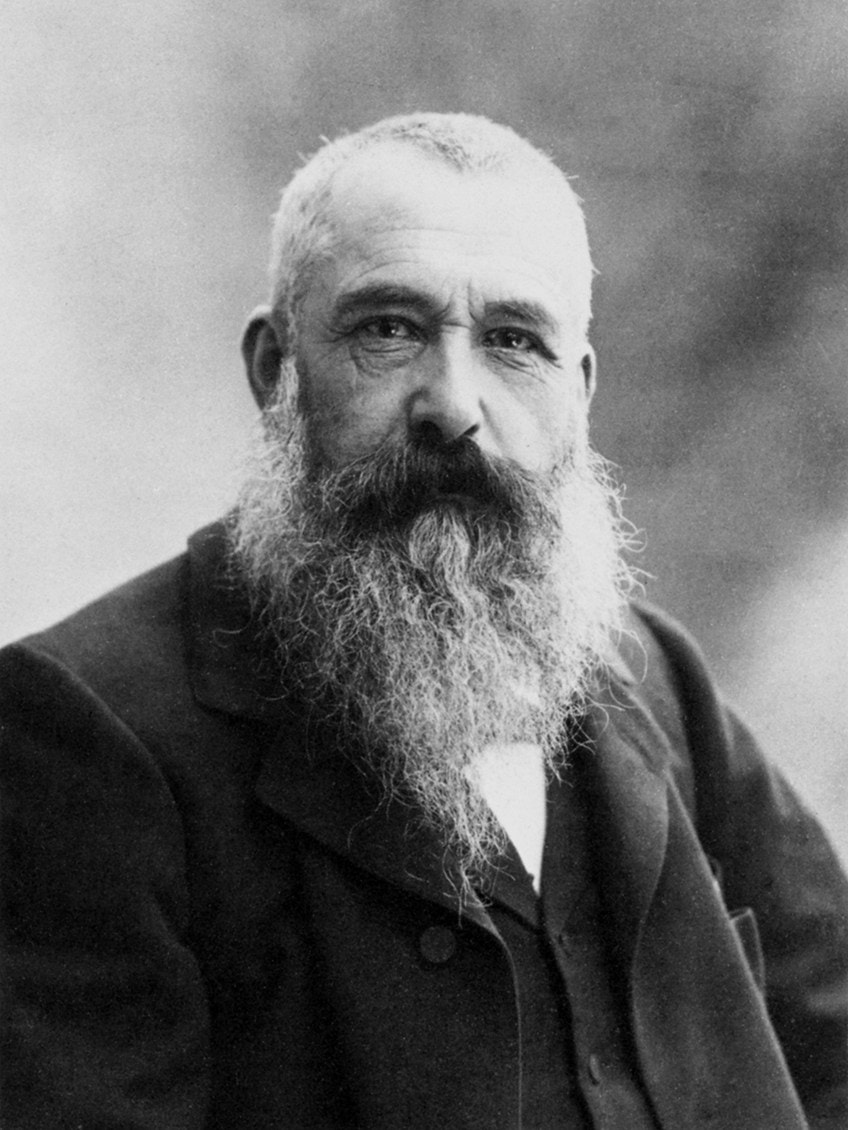 Portrait of Claude Monet in 1899;Nadar, Public domain, via Wikimedia Commons
Portrait of Claude Monet in 1899;Nadar, Public domain, via Wikimedia Commons
These included Eugène Boudin and Jonah Barthold Jongkind, as well as many of the Impressionist artists who Monet knew through the group he started called the "Anonymous Society of Painters, Sculptors, and Engravers". Monet lived in Giverny during the later years of his life with his second wife and children. It was also in Giverny where he started producing his famed series of paintings, Water Lilies, of which he produced over 200 paintings; he was deeply inspired by his Japanese water garden and the various water lilies and plants that grew there. He died in December 1926.
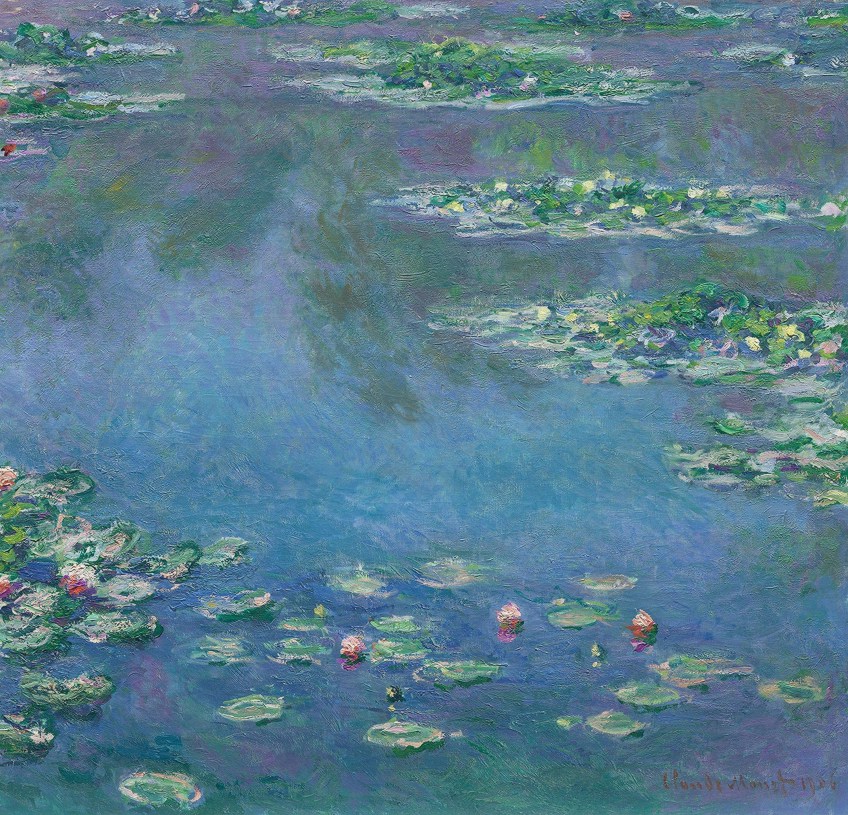 Water Lilies (1906) by Claude Monet;Claude Monet, Public domain, via Wikimedia Commons
Water Lilies (1906) by Claude Monet;Claude Monet, Public domain, via Wikimedia Commons
Woman With a Parasol (1875) by Claude Monet in Context
The great outdoors has always been a subject of painting for artists, just as much as people have been. Now imagine the two combined, which is a subject we see throughout the myriad of Impressionism artworks – one artist who coupled this well was Claude Monet.
He captured a fleeting moment with his paintbrush and created a canvas filled with color that translated into a light show.
This article will discuss one example from Monet's many paintings, namely Woman with a Parasol (1875), which is also titled Madame Monet and Her Son or The Stroll. Below, we will start with a brief contextual analysis of the social and artistic influences that surrounded Monet at the time he painted.
We will then discuss a formal Woman with a Parasol analysis taking a closer look at Monet's subject matter and stylistic approaches in terms of color, brush strokes, and other formal elements.
| Artist | Oscar-Claude Monet |
| Date Painted | 1875 |
| Medium | Oil on canvas |
| Genre | Genre painting |
| Period / Movement | Impressionism |
| Dimensions | 100 x 81 centimeters |
| Series / Versions | Not applicable |
| Where Is It Housed? | National Gallery of Art, Washington DC, United States |
| What It Is Worth | Estimated worth ranges in the millions |
Contextual Analysis: A Brief Socio-Historical Overview
Before we look at Monet's Woman with a Parasol painting it will help to back a few years and look at the circumstances that shaped not only Monet's artwork but many other painters who identified as Impressionists. This occurred in Paris during the late 1800s when the perception and development of art took a turn, a turn away from the French Academy and its Academic painting styles.
It Started with An Impression, Sunrise
It all started with an Impression, Sunrise (1872), a painting that Monet exhibited in 1874 at the first exhibition of the anonymous group of artists called Société Anonyme Coopérative des Artistes Peintres, Sculpteurs, Graveurs, in English it means "Cooperative and Anonymous Association of Painters, Sculptors, and Engravers".
Some of the artists from this group were Claude Monet, Camille Pissarro, Pierre-Auguste Renoir, Edgar Degas, Alfred Sisley, Paul Cézanne, and many others.
This was also one of the first, and independent, groups of artists who revolted against the traditional standards from the French Academy and the Salon, which was the primary exhibition event held each year in Paris, sometimes biannually.
The term "Impressionism" was given to the group of independent artists when Louis Leroy wrote a review about the exhibition in the Le Charivari magazine, which was primarily satirical and comical. Leroy's review was reportedly titled "The Exhibition of the Impressionists", the word he used from Monet's painting Impression, Sunrise (1872).
 Impression, Sunrise (1872) by Claude Monet;Claude Monet, Public domain, via Wikimedia Commons
Impression, Sunrise (1872) by Claude Monet;Claude Monet, Public domain, via Wikimedia Commons
Even though the review was critical to the point of derision the name apparently found itself a home and the artists subsequently used it to describe their new and different style of painting. But what was this new and different style of painting exactly?
Impressionists sought to depict everyday life and moments as they happened, and this would often involve painting the moment in time in a hasty manner, which made the brushstrokes appear loose and expressive, many describe this style of painting as appearing "unfinished" compared to the perfectly executed figures we would see from paintings exhibited at the Salon.
But Impressionists were not interested in painting perfectly, they were interested in how color conveyed light and how the light fell on people and places creating swathes of shadows, which would then be translated through color and brushstrokes. Sometimes the subject matter would not be recognizable amidst the colors and brushwork.
This was in fact what Impressionism meant, artists painted the "impression" of a scene. Furthermore, many Impressionists painted en plein air , which means "outdoors" and captured many scenes outdoors from nature as well as people in the natural environment.
A Brief Note About the Predecessors of Impressionism
Although Claude Monet has always been regarded as one of the founding fathers of the Impressionism movement, he and many of the Impressionist artists were also influenced by other artistic styles that impacted their Impressionistic style and led to their establishment in the art society.
One of these influences was the Barbizon School, which was in the French village called Barbizon. This is an important point to note because of Barbizon's stylistic approaches, which were mainly characterized by their "naturalistic" portrayal of the environment or people.
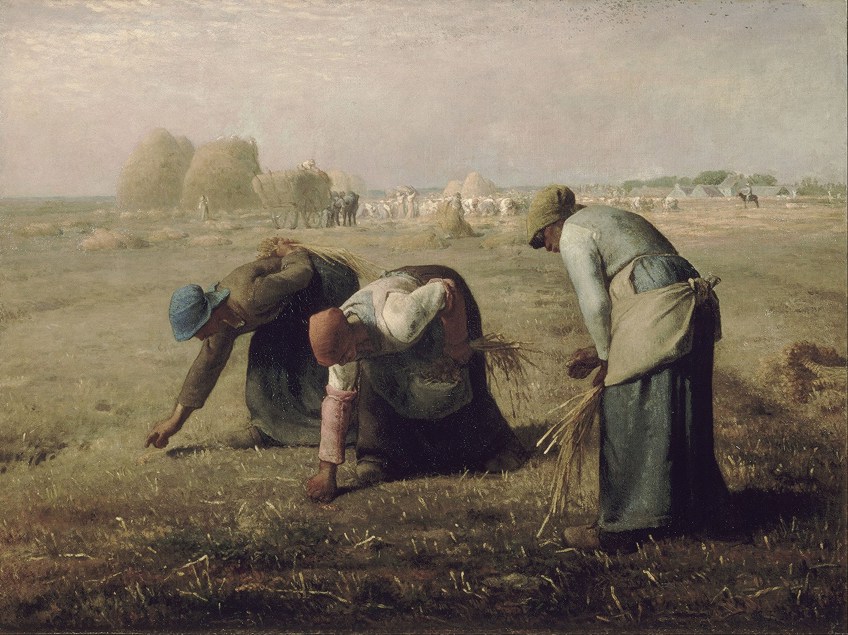 The Gleaners (1857) by Jean-François Millet ;Jean-François Millet, Public domain, via Wikimedia Commons
The Gleaners (1857) by Jean-François Millet ;Jean-François Millet, Public domain, via Wikimedia Commons
The Barbizon artists painted in the en plein air style and were interested in depicting landscapes scenes that were as they saw them and not as they would be expected to appear through the lens of traditional painting from movements like Neoclassicism, which is an art style they moved away from. Furthermore, their style was also characterized by more expressive brushstrokes, their use of color, and other elements that described them as painting in a Realism style.
Some of the leading artists from the Barbizon School included Jean-Baptiste-Camille Corot, Charles-François Daubigny, Jules Dupré, Charles Jacque, Théodore Rousseau, and many others who also joined the group of artists at a later stage; the group lasted from around 1830 to around 1870.
Other noteworthy influencing artists were Johan Barthold Jongkind and Eugène Louis Boudin. The Dutch Jongkind was considered a teacher to not only Monet but Boudin too. He also painted landscapes, predominantly around marine themes; he was an exemplar of the en plein air style. His style has been described as having a free approach and many believe he was one of the predecessors of Impressionism.
Formal Analysis: A Brief Compositional Overview
Now that we have more context about what the world of art was like when Monet painted, we can better understand his Woman with a Parasol painting. Below we delve deeper into what, and who, this painting is showing to us.
What makes this painting so intriguing is that the subject matter cannot be discussed without discussing the brushstrokes and color, which ultimately give it its shape and movement. It has also been suggested that Monet may have painted his Woman with a Parasol either in a single sitting or several hours.
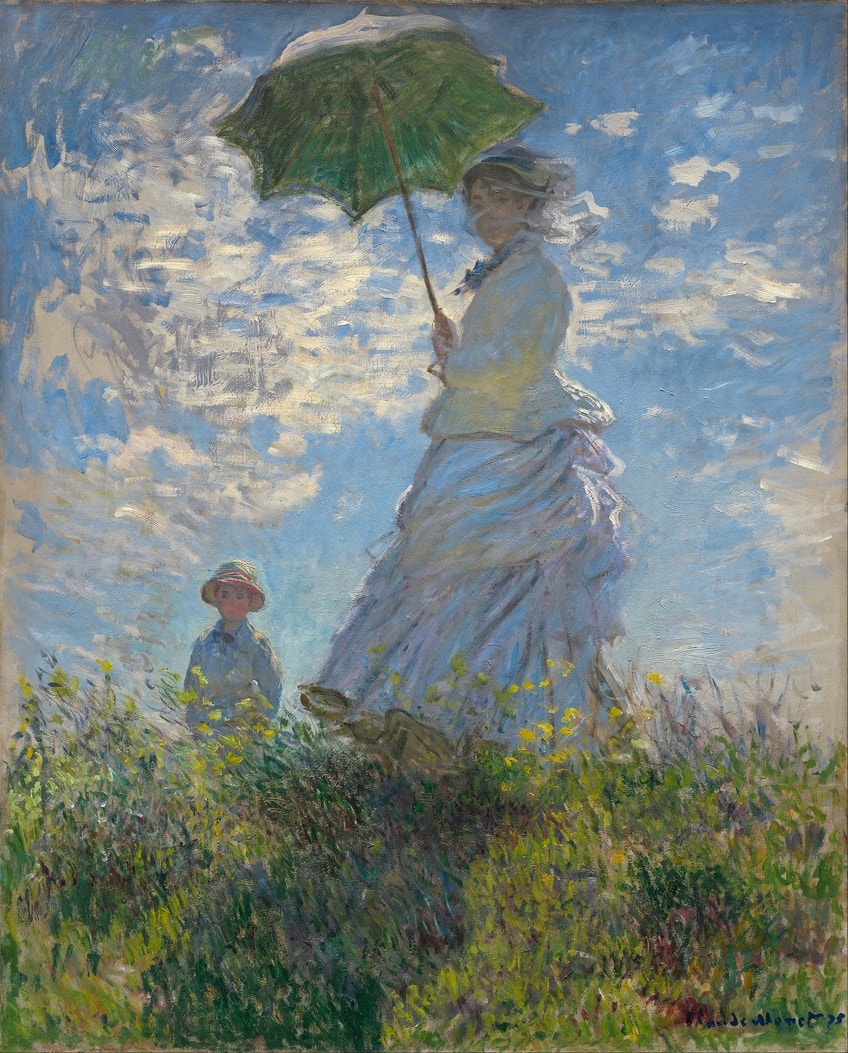 Woman With a Parasol (1875) by Claude Monet;Claude Monet, Public domain, via Wikimedia Commons
Woman With a Parasol (1875) by Claude Monet;Claude Monet, Public domain, via Wikimedia Commons
It is suggested that while we may discuss the painting by separating its different formal components, starting with the subject matter, these all interplay and connect the painting as one. Therefore, as you look at the subject matter, keep the brushwork and colors in mind and how these inform the subject matter.
Equally, as we discuss the brushwork and colors, keep in mind how these inform the movement and light depicted in the painting, which is predominantly why Monet painted this scene – to explore the effects of light on his subject matter.
Subject Matter
The Woman with a Parasol painting is also usually titled with the joining part, Madame Monet and Her Son. Madame Monet was originally named Camille-Léonie Doncieux, who married Monet in 1870. They had two sons, Jean, who was born in August 1867, and Michel Monet, who was born in March 1878. In this painting, Monet painted Jean, his first son, as his second son was not born yet.
Claude Monet painted both figures in several of his other paintings too.
We see the two figures standing together on an embankment; the bottom third of the painting is composed of the green grassy bank and the upper part, about two-thirds of the composition is dominated by the two figures and the expanse of the blue sky and white clouds behind them.
The woman, or Camille, appears to be looking downwards at us, the viewers. She is standing in a side profile holding her parasol with both her hands cupped over its handle. She wears a white dress, typical of the fashion from the 1800s when this was painted.
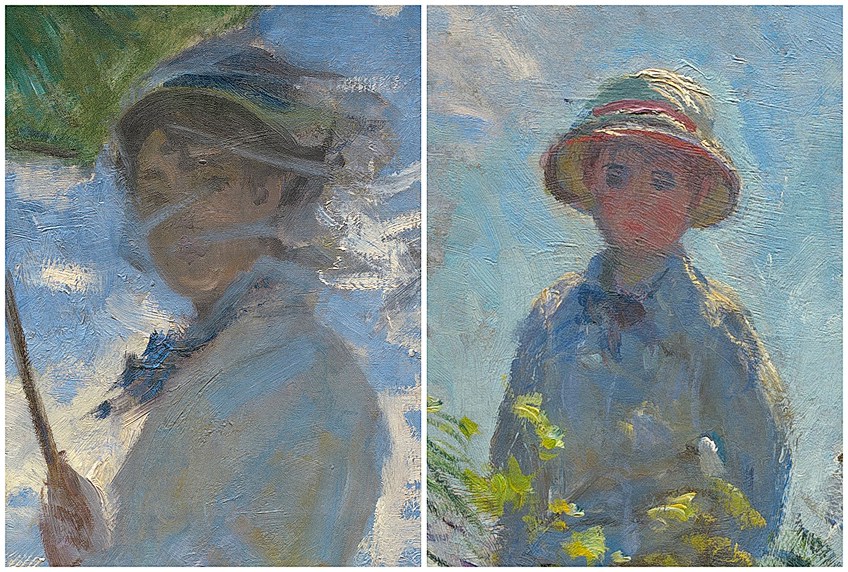 A close up of Camille and Jean's faces, respectively, in Woman With a Parasol (1875) by Claude Monet;Claude Monet, Public domain, via Wikimedia Commons
A close up of Camille and Jean's faces, respectively, in Woman With a Parasol (1875) by Claude Monet;Claude Monet, Public domain, via Wikimedia Commons
The boy, or Jean, stands to his mother's right (our left) in a full-frontal position, facing us. He is wearing a hat and a white outfit. We cannot evince much of his lower torso as there are long strands of grass in front of him, but he appears to have his hands in his pockets.
The longer strands of grass from the forefront of the composition are a part of the background where the two figures stand. The foreground and background do not appear too distinct from the other but help us compartmentalize different aspects of the painting.
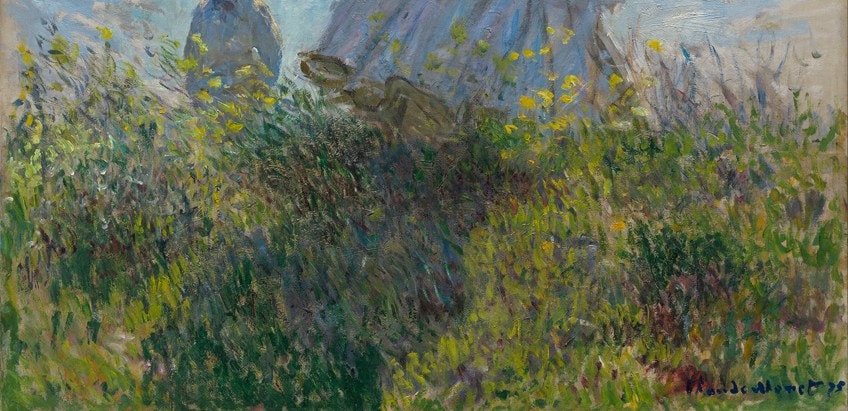 The grass in Woman With a Parasol (1875) by Claude Monet;Claude Monet, Public domain, via Wikimedia Commons
The grass in Woman With a Parasol (1875) by Claude Monet;Claude Monet, Public domain, via Wikimedia Commons
Furthermore, the grass that appears to be billowing closer in the foreground making it appear as if the boy is standing right in between it indicates how the two figures are a part of the natural environment, making the scene even more naturalistic, capturing the moment as it is. If we look at the parasol, it is a darker shade of green held over the woman's head. This points us to where the light is also coming from as Monet painted the two figures standing against the backdrop of light.
We see the vast expanse of blue sky behind them dappled with floating white clouds, which Monet painted in an assortment of dashes of brushstrokes.
 The parasol and the sky in Woman With a Parasol (1875) by Claude Monet;Claude Monet, Public domain, via Wikimedia Commons
The parasol and the sky in Woman With a Parasol (1875) by Claude Monet;Claude Monet, Public domain, via Wikimedia Commons
The entire composition has movement to it, the way Camille is standing in the wind and the way Monet painted the flowing ribbons here and there all add to the dynamism. We also see the wind blowing through the grass at the forefront of the composition.
Color and Light
Color and light are almost the primary subject matter in Monet's Woman with a Parasol painting. This painting needs to be viewed from afar and from close to feel the depth of Monet's fleeting moment. We see beautiful shades of blues, whites, greens, yellows, and hints of purple-reds and oranges.
The figures' shadows fall onto the embankment in the foreground because of the direction of the light behind them.
Monet utilized darker shades of colors to give the impression of the shadows on the grass, painting the grass in deeper greens, we even see some deeper shades of reds. The shadows come alive with colors, yet Monet still conveyed the contrast in light and dark.
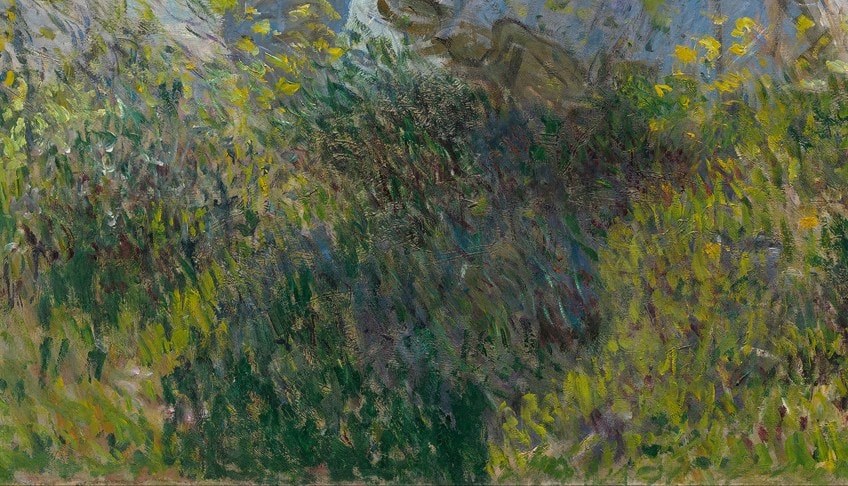 The use of shadow in Woman With a Parasol (1875) by Claude Monet;Claude Monet, Public domain, via Wikimedia Commons
The use of shadow in Woman With a Parasol (1875) by Claude Monet;Claude Monet, Public domain, via Wikimedia Commons
The sky and clouds are painted in what appears to be predominantly white and blue, but if we look closer, we will see how Monet applied grays too to depict the interplay of light and shadow between the sky and the various formations of clouds.
Additionally, if we look at how Monet painted the clouds in the sky, we will notice his use of wider and thicker brushstrokes that give the impression of more light. This is also evident on the back of Camille's dress where we will notice thick strands of paint to indicate how the light falls on that spot.
 Light in Woman With a Parasol (1875) by Claude Monet;Claude Monet, Public domain, via Wikimedia Commons
Light in Woman With a Parasol (1875) by Claude Monet;Claude Monet, Public domain, via Wikimedia Commons
We also see a thicker application on the deep greens of the parasol and the evident linearity of the brushstrokes as they move down the parasol's arching shape, also simultaneously enhancing its shape.
Although Camille's dress is white, we see various colors, which are indicative of the shadow falling on her. We will also notice how Monet utilized a deeper yellow near Camille's left elbow to indicate how the light reflects on her, possibly from the yellows of the grass and flowers on the embankment.
 A detail of Woman With a Parasol (1875) by Claude Monet;Claude Monet, Public domain, via Wikimedia Commons
A detail of Woman With a Parasol (1875) by Claude Monet;Claude Monet, Public domain, via Wikimedia Commons
While there is considerably more to say about how Monet applied his paint, and the various thicknesses and thinness of his brushstrokes, what we can take away from this is that color becomes light, and light becomes color, which includes the shadows.
This was such an important part of what characterized not only Monet's artworks and his focus but also Impressionism as an art movement.
Perspective
In Woman with a Parasol Claude Monet painted the scene from a lower point of view. Camille and Jean stand from a higher vantage point, reached by the embankment, however, Jean appears to stand slightly further behind his mother, who is standing seemingly right on the edge of where the embankment starts to level out.
As we notice how Camille is looking down at Monet, and ultimately at the viewers, we are also met with the largely blue sky behind her. This lower viewpoint also facilitates the inclusion of the sky in the composition, which creates more lighting effects.
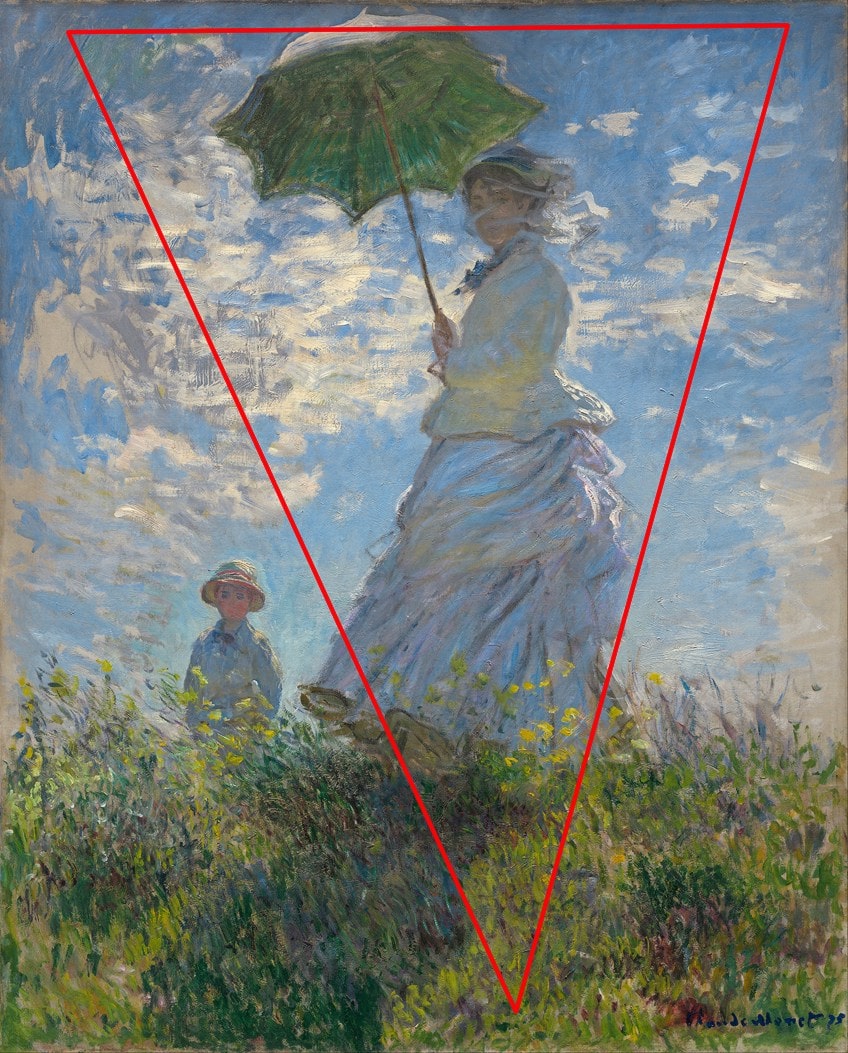 The angle at which Woman With a Parasol (1875) by Claude Monet is painted gives the impression that the figures are looking down at us, creating a kind of triangular perspective;Claude Monet, Public domain, via Wikimedia Commons
The angle at which Woman With a Parasol (1875) by Claude Monet is painted gives the impression that the figures are looking down at us, creating a kind of triangular perspective;Claude Monet, Public domain, via Wikimedia Commons
Monet: Capturing the Moment
Monet painted similar paintings a few years after, also of figures outdoors, for example, Woman with a Parasol Facing Right (1886) and Woman with a Parasol Facing Left (1886) also depicts a woman posing with a parasol, and all the natural elements inform Monet's exploration of formal elements like color, light, perspective, and brushwork.
Monet would continue his artistic oeuvre by creating his famous Water Lil ies series from the 1900s, but even after his death, he continued to inspire many artists for years to come. A notable example includes the Abstract Expressionist Jackson Pollock.
When looking at Monet's paintings we might wonder, who needs a camera to capture a moment? Maybe this is an exaggeration, but it points at Monet's beautiful artistry and ability to capture a moment in time with a paintbrush, breathing life into his compositions with each brushstroke. This is exactly what we explored in the above "Woman with a Parasol" analysis.
Take a look at ourWoman with a Parasolpainting webstory here!
Frequently Asked Questions
Who Painted The Woman with a Parasol?
The Woman with a Parasol (1875) is an oil on canvas painted by the Impressionist Claude Monet.
Who Are the Figures in Monet's The Woman with a Parasol Painting?
Claude Monet painted The Woman with a Parasol (1875) while he was possibly out and about with his family one day. The woman was his first wife Camille Monet and the boy standing next to her was their eldest son, Jean Monet. This painting has often been described as not falling into the category of portraiture.
devillethusecomang.blogspot.com
Source: https://artincontext.org/woman-with-a-parasol-claude-monet/
0 Response to "Impressionism Woman Sitting Profile Outdoor White Dress Stream"
Post a Comment